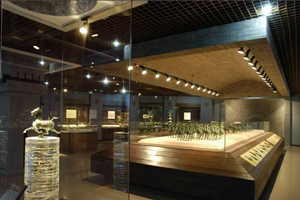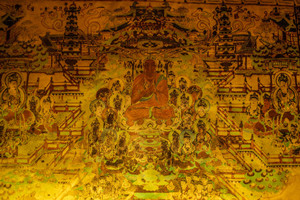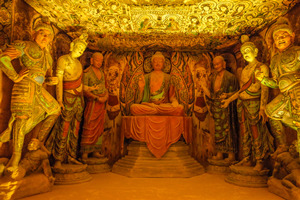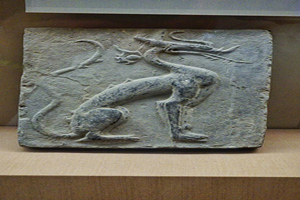Chinese Name: 敦煌博物馆 Pronunciation: dūn huáng bó wù guǎn
Admission Ticket Fare: Free
Suggested Visiting Hours: 1-3 Hours
Building Time: 1979
Occupied Area: 7,500 square meters
Best Visiting Time: All year round
Address: 1390 Mingshan North Road, Dunhuang City, Gansu Province
Building Function: It is built to promote Dunhuang culture and to show the ancient civilization of Dunhuang.
|
Peak Season (May-September)
|
Low Season (October-April)
|
|
| 9:00-18:30 (no entry after 17:30) | 9:00-18:00 (no entry after17:00) | |

The museum construction area is 16,000 square meters. The architectural plan is designed by the architect Cui Kai of the China Architecture Design and Research Institute. The overall shape of the building is integrated with cultural symbols such as the Great Wall, Fengsui, and ancient castle-style buildings. It is beautiful, solemn and generous. The new building covers an area of 7,500 square meters. There are exhibition halls, cultural relics warehouses, screening halls, and lounges.
Dunhuang Museum houses more than 4,000 cultural relics. The first part focuses on the documents from Dunhuang Mogao Grottoes. The second part focuses on the cultural relics unearthed from the tombs of the Han Dynasty, Jin Dynasty, Sui Dynasty, Tang Dynasty and other dynasties, which are mainly stone steles, stone towers, pottery boxes, pottery tripods, stone beast. The third part focuses on exhibits of silk brocade, spun silk, yarn and other physical objects.
Among them, the Dunhuang Manuscripts unearthed from the famous Mogao Buddhist Scripture Cave and the rare Tibetan scriptures in the world which are the treasures of the museum.
The Dunhuang Museum is responsible for the collection, publicity, management, investigation, and maintenance of cultural relics in the city. It is a comprehensive museum with integrating cultural relics protection, research, collection, and display. It has standard cultural relics warehouses and cultural relics exhibition halls. More than 1,000 cultural relics are on display.
The Dunhuang Museum was established in October 1979. It was named as the Archaeological Group of the County Cultural Center before, which was rebuilt in 1984. The current museum was rebuilt and completed in 2011.
In 2008, Dunhuang Museum was listed as one of first free admission museums in Gansu Province. In 2013, it was rated as the Third Level National Museum.

Exhibition Hall 1 introduces the great development of Dunhuang in the Han Dynasty. The Han Dynasty is a new era of Dunhuang history. It is divided into the Western Han and Eastern Han. A large number of graphic boards and unearthed cultural relics show the prosperity of the Silk Road during the Han Dynasty. The visitors can enjoy the magnificent scene of silk trade and the gathering of merchants in the Han Dynasty, and have a deep understanding of the military, political, economic and cultural development of Dunhuang at that time. It truly reproduces the magnificent production and life scenes of the Dunhuang people during the Han Dynasty and the spread of Buddhism to the east.

Exhibition hall 2 presents the continuous development of Dunhuang during the Wei, Jin, Southern and Northern Dynasties. The Wei, Jin, Southern and Northern Dynasties constitute a very important historical period in Dunhuang history. The unearthed cultural relics are very rich. Like tiles, soldiers' weapons and daily necessities, all of these reflect the prosperous culture of this period. The artifacts unearthed in this period are also very distinctive, such as a town tomb pot with both the exquisite chic and research value, the colorful chicken head stove, the bronze crossbow machine owned by the soldiers of the ancient border, and the pottery warehouse. All the relics reflect the real life situation in ancient times.

Exhibition hall 3 presents the prosperity of Dunhuang in the Sui and Tang Dynasties. The Sui, Tang and Five Dynasties were the most glorious period in Dunhuang history. At that time, social production, economic and culture reached their peak. Dunhuang had become an important position in the transportation hub of China and the West. The unearthed precious cultural relics such as beads, go chess, jade, pottery, and camel figurines fully prove the historical facts of Dunhuang being an important developed commercial city, an international market, and a gathering of Hu businessmen (Western people) in the Tang Dynasty. The Five Dynasties are a special scene in the history of Dunhuang, and the economic culture is in the same line with the Tang Dynasty.

Exhibition hall 4 presents development of Tubo and the Five Dynasties and Song, Yuan and Ming dynasties. It focuses on telling the visitors about the history and culture of Xixia(1038-1227). The overall exhibition reflects the style of Xixia and shows the rugged and bold character of the Xixia nation. After the Song Dynasty, with the decline of the Silk Road, the economic and cultural prosperity of Dunhuang began to decline. During the Yuan and Ming Dynasties, the Mongolian and Yuan government conducted effective management of Dunhuang, so that Dunhuang, the gateway to the Western Regions, once again became unblocked, and Dunhuang's economy and culture flourished once again.
Exhibition Hall 5 presents the development of Dunhuang in the Qing Dynasty. It focuses on introducing the Dunhuang posthumous books in the Dunhuang Museum, inspiring people's patriotic enthusiasm, expressing the feelings of the Chinese people, showing the artistic charm of Dunhuang studies, and enhancing the cohesion and centripetal force of the Chinese nation.
Take Bus No. 3 directly to the Museum Station.
By Taxi
Chinese: 请带我去敦煌博物馆。English: Please take me to the Dunhuang Museum.
